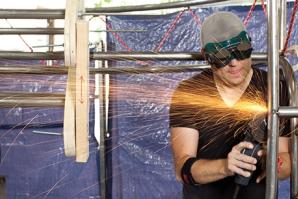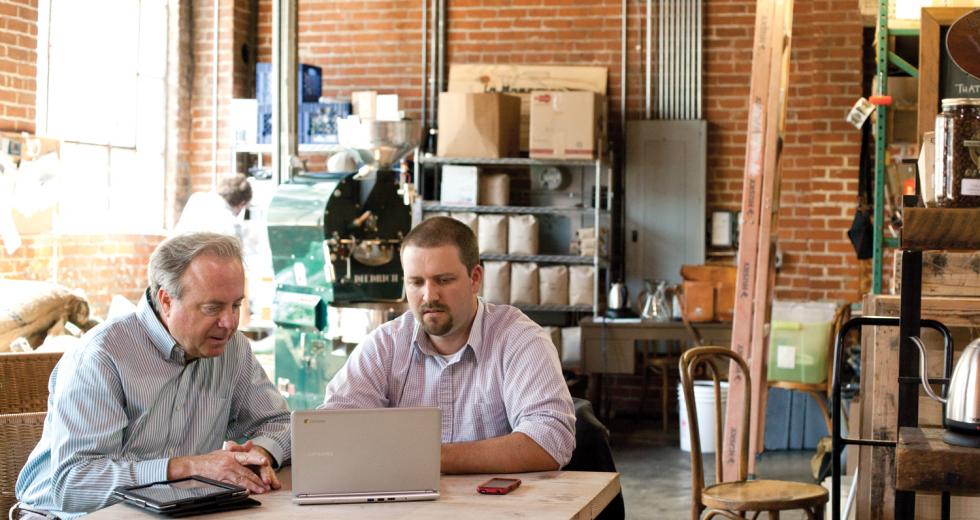During his years as a state agency employee, Fred Pilot spent three hours a day driving to and from his Sacramento office.
These days, he logs a 15-second commute.
“I was spending 15 hours a week (commuting) to sit and use my computer,” says Pilot, now an independent health policy consultant and writer. “Now I use it at home. It makes no sense to me.”
Pilot, who lives in El Dorado County, is part of a small but growing faction of workers in the Sacramento area who perform their jobs outside of a traditional office. Nearly 49,000 individuals — about 5.5 percent of the region’s total workforce — reported working from home in 2010, according to U.S. Census figures. That’s up from about 42,000 workers in 2005. Nationally, 13.4 million people worked from home at least one day a week in 2010, a 35-percent jump from the decade prior.
Pilot wants to see those numbers grow to a point where location-flexible work opportunities are norm, not the exception, for both independent contractors like himself and what he calls “knowledge economy,” workers employed by larger organizations. To achieve that goal, he’s partnered with Sacramentan Ryan Arba to launch workanywherenation.org, a “social influence campaign” promoting a move away from the centralized office.
Pilot and Arba see those offices and the traditional 8-hour workday as inefficient and outdated relics of the industrial age, when a set shift and common location were vital for communicating and performing work.
“The idea that you need to do the thought/creative work in an assembly line sort of (environment) doesn’t make a whole lot of sense, particularly when you have access to all the information in the world right now on the Internet,” Pilot says.
“We’re saying, you can think anywhere,” says Arba, who currently works for the state. “If you have a laptop, you can write. If you have an Internet connection, you can communicate.”
Arba and Pilot believe such a shift will lead to workers who are more productive and happier as they craft a routine that works best for their professional, health and family needs.
The Work Anywhere Nation vision isn’t without challenges or critics, though. Yahoo’s new chief executive officer, Marissa Mayer, made headlines by rescinding the tech giant’s flexible work policies. And Arba and Pilot are hard-pressed to identify any major companies in the Sacramento region or beyond that rely entirely on the work model they’re advocating.
Still, Arba and Pilot say there are ways to make such a transition easier and more workable for both employees and employers:
INVEST IN TOOLS THAT WORK FOR THE COMPANY — AND THE EMPLOYEE
Moving to a cloud system, where information is stored on Web-based servers that can be accessed from anywhere, is key to making remote work possible. “The knowledge and information world is going to the cloud, and in that process, it’s basically [making obsolete] how we’ve done it for decades, commuting to the office,” Pilot says. Tools like Skype, online document sharing, editing programs and other Web resources allow colleagues to communicate and collaborate without sitting in neighboring cubicles or around a conference table. Relying on Web-based programs means work can be done anywhere Wi-Fi is available, often at a fairly low cost. For Arba, a $250 Chromebook is sufficient for accessing email and basic word processing software. Pilot prefers to use a desktop in his home office and an iPad on the go.
MANAGE WORK, NOT PEOPLE
Arba and Pilot envision a fundamental shift in work culture wherein employers change not only where employees work but how they are evaluated. That means workers are “measured by their work instead of their attendance and their face time,” Arba says. Such an approach allows employees to complete assignments when they are most creative and productive, whether that is first thing in the morning or in the evening hours. It also gives them an incentive to get their work done faster. “Because people have time ownership in that kind of world, we would hope individuals would learn ways to be more efficient and effective in their work,” he says.
MAKE WORKPLACE FLEXIBILITY THE RULE, NOT THE EXCEPTION
The concept goes beyond what many consider “telework” these days — employers allowing some staff to work from home on Fridays or jump on a conference call remotely while they’re waiting for the cable guy. Arba recalls speaking to one colleague who was elated that her manager would let her leave early on days her daughter had doctors’ appointments.
Making such arrangements the exception not the rule means employees taking advantage of the schedule could be left a disadvantage, potentially missing crucial communication or resented by coworkers.
“It almost has to go beyond putting these BandAids on the industrial age model and saying, ‘Oh, you can telecommute on Fridays, We’ll give you permission to do that so you can be a good mom on Fridays,’” says Arba, who is expecting his first child with his wife.
“Why can’t I be a good, dedicated employee and also be my future son or daughter’s baseball coach? Why does that have to be mutually exclusive?” Arba and Pilot believe giving all employees the tools and option to work from anywhere creates a more level playing field that allows all workers to balance professional and personal responsibilities.
IDENTIFY YOUR MOST PRODUCTIVE WORKSPACE
Arba and Pilot aren’t advocating eliminating offices altogether. In fact, Pilot is a big fan of co-working spaces that allow individuals from different organizations or professions to come together in a shared office, such as midtown Sacramento’s The Urban Hive. What matters most though, he says, is that you find a place where you can “concentrate and be productive.”
“Some people can do that in a noisy Starbuck’s, some people need it quieter. Some people have space in their homes, as I do, while some people have too many distractions,” he says.
“A centralized commuter office is one size fits all.” Don’t limit yourself to work spots with a traditional table or desk for your laptop. Pilot says he gets a lot of his best thinking done on an exercise bike, while Arba enjoys working through complex problems while sitting in his backyard.
Recommended For You

Independents’ Day
Look out 9-to-5, the freelancers are coming
Casey Marshall is hunched over his phone, furiously scrolling through his Twitter feed in search of a photo of Waste Management’s promotional robot, whose broken axle he fixed back in March. “Someone came into the Hacker Lab and needed his robot repaired,” he says, grinning, “and I was like, ‘I gotta do that.’”

Brain Drain
How can Sacramento keep its millennials in the mix?
About a decade ago, as a financial analyst for Intel, I lived in the suburbs of Santa Clara and frequently traveled to Folsom. It was a good job, especially for a kid straight out of college — decent pay, strong company and the lure of glittering stock options.
So I left.



